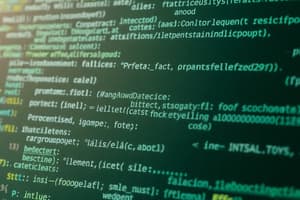Podcast
Questions and Answers
What are algorithms?
What are algorithms?
Step-by-step instructions used to solve a problem
Why are algorithms considered the lifeblood of programming?
Why are algorithms considered the lifeblood of programming?
They provide the blueprint for problem solving
Name three types of algorithms and provide an example for each.
Name three types of algorithms and provide an example for each.
Sorting (e.g., Quicksort, Merge Sort), searching (e.g., Linear Search, Binary Search), graph traversal (e.g., Breadth-First Search, Depth-First Search)
What are data structures?
What are data structures?
Why are data structures essential to programming?
Why are data structures essential to programming?
What are some common coding standards mentioned in the text?
What are some common coding standards mentioned in the text?
How do coding standards contribute to code quality?
How do coding standards contribute to code quality?
What are design patterns, and how do they benefit software design?
What are design patterns, and how do they benefit software design?
Why is it essential to understand the principles of programming?
Why is it essential to understand the principles of programming?
What is the importance of continuous learning for a programmer?
What is the importance of continuous learning for a programmer?
Study Notes
Title: Unraveling the Principle of Programming: Algorithms, Data Structures, Coding Standards, and Design Patterns
Programming, a fascinating realm of code and logic, is the bedrock of modern technology. It's not just about writing lines of code; it's about crafting efficient, scalable, and maintainable solutions with a keen understanding of the underlying principles. In this educational piece, we will delve into the core aspects of programming: algorithms, data structures, coding standards, and design patterns.
1. Algorithms
Algorithms are step-by-step instructions used to solve a problem. They are the lifeblood of programming, as they provide the blueprint for problem solving. A well-designed algorithm ensures that the task is completed in a timely and efficient manner.
There are many types of algorithms, such as sorting (e.g., Quicksort, Merge Sort), searching (e.g., Linear Search, Binary Search), and graph traversal (e.g., Breadth-First Search, Depth-First Search). Each algorithm is unique, catered to solve specific problems or perform specific tasks.
2. Data Structures
Data structures are collections of data elements that provide efficient access and manipulation. They are essential to programming because they offer a way to store and retrieve data in an organized manner. Some common data structures include arrays, linked lists, queues, stacks, trees, and graphs.
For example, a linked list is an efficient data structure used to store data elements that do not need to be accessed randomly. A tree data structure can be used to represent a hierarchy or organize data in a hierarchical manner. Understanding data structures and their properties is crucial for designing efficient algorithms.
3. Coding Standards
Coding standards ensure that the code is consistent and adheres to best practices. They provide a guideline for how code should be written, formatted, and documented. Some common coding standards include Google's Python Style Guide, Java's Sun Code Conventions, and PEP 8 (Python Enhancement Proposal 8) for Python.
Coding standards help to make code more readable, maintainable, and easier to debug. They also provide a way to standardize the codebase, which can help to reduce errors and improve collaboration among team members.
4. Design Patterns
Design patterns are proven solutions to recurring problems in programming. They provide a way to reuse well-tested and proven designs in new projects. Some common design patterns include the Singleton pattern, the Observer pattern, and the Factory pattern.
Design patterns help to improve software design by providing a way to structure code in a modular and flexible manner. They also help to improve code readability and maintainability, as well as to reduce the likelihood of making errors.
Conclusion
Understanding the principle of programming is essential for writing efficient, scalable, and maintainable code. Algorithms, data structures, coding standards, and design patterns are the cornerstones of programming, and mastering them is key to success. By leveraging these principles, we can create software that is not only functional but also reliable, efficient, and easy to maintain.
As a programming enthusiast, it's important to stay up-to-date with the latest tools, technologies, and best practices. Continuous learning will help you to become a better programmer and to create software that meets the needs of the modern world. So, keep coding, keep learning, and keep pushing the boundaries of what's possible!
Studying That Suits You
Use AI to generate personalized quizzes and flashcards to suit your learning preferences.
Description
Explore the fundamental aspects of programming including algorithms, data structures, coding standards, and design patterns. Learn how these principles contribute to crafting efficient, scalable, and maintainable solutions, essential for success in the dynamic realm of code and logic.




